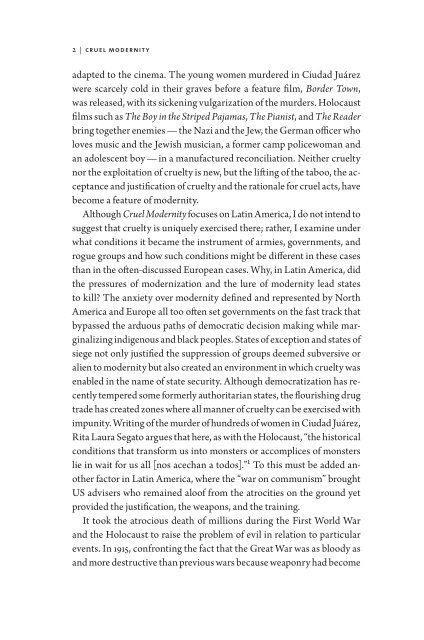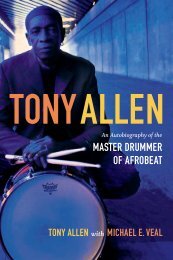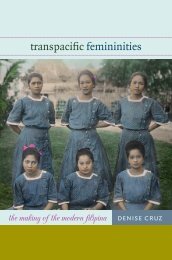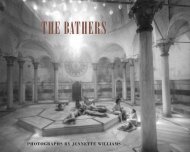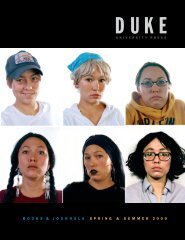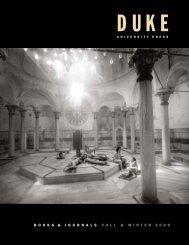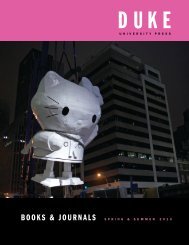Cruel Modernity JEAN FRANCO - Duke University Press
Cruel Modernity JEAN FRANCO - Duke University Press
Cruel Modernity JEAN FRANCO - Duke University Press
Create successful ePaper yourself
Turn your PDF publications into a flip-book with our unique Google optimized e-Paper software.
2 | cruel modernity<br />
adapted to the cinema. The young women murdered in Ciudad Juárez<br />
were scarcely cold in their graves before a feature film, Border Town,<br />
was released, with its sickening vulgarization of the murders. Holocaust<br />
films such as The Boy in the Striped Pajamas, The Pianist, and The Reader<br />
bring together enemies — the Nazi and the Jew, the German officer who<br />
loves music and the Jewish musician, a former camp policewoman and<br />
an adolescent boy — in a manufactured reconciliation. Neither cruelty<br />
nor the exploitation of cruelty is new, but the lifting of the taboo, the acceptance<br />
and justification of cruelty and the rationale for cruel acts, have<br />
become a feature of modernity.<br />
Although <strong>Cruel</strong> <strong>Modernity</strong> focuses on Latin America, I do not intend to<br />
suggest that cruelty is uniquely exercised there; rather, I examine under<br />
what conditions it became the instrument of armies, governments, and<br />
rogue groups and how such conditions might be different in these cases<br />
than in the often-discussed European cases. Why, in Latin America, did<br />
the pressures of modernization and the lure of modernity lead states<br />
to kill? The anxiety over modernity defined and represented by North<br />
America and Europe all too often set governments on the fast track that<br />
bypassed the arduous paths of democratic decision making while marginalizing<br />
indigenous and black peoples. States of exception and states of<br />
siege not only justified the suppression of groups deemed subversive or<br />
alien to modernity but also created an environment in which cruelty was<br />
enabled in the name of state security. Although democratization has recently<br />
tempered some formerly authoritarian states, the flourishing drug<br />
trade has created zones where all manner of cruelty can be exercised with<br />
impunity. Writing of the murder of hundreds of women in Ciudad Juárez,<br />
Rita Laura Segato argues that here, as with the Holocaust, “the historical<br />
conditions that transform us into monsters or accomplices of monsters<br />
lie in wait for us all [nos acechan a todos].”1 To this must be added another<br />
factor in Latin America, where the “war on communism” brought<br />
US advisers who remained aloof from the atrocities on the ground yet<br />
provided the justification, the weapons, and the training.<br />
It took the atrocious death of millions during the First World War<br />
and the Holocaust to raise the problem of evil in relation to particular<br />
events. In 1915, confronting the fact that the Great War was as bloody as<br />
and more destructive than previous wars because weaponry had become


